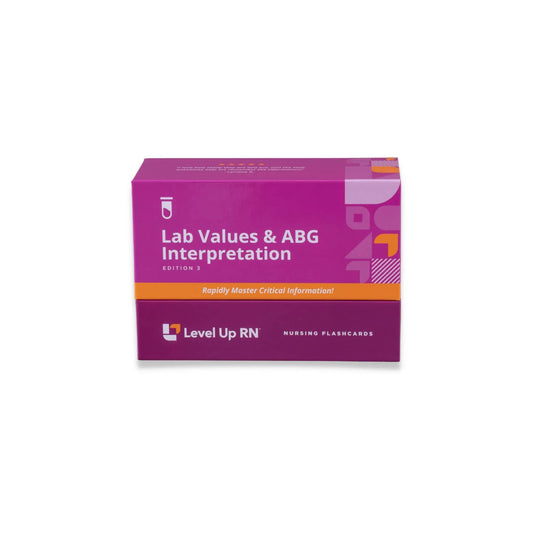Lab Values, part 25: Ammonia
Ammonia: its function in the body, expected range, and possible causes of elevated levels.
Quiz Questions
Elevated ammonia levels are most commonly associated with which neurological condition?
Elevated ammonia levels are most commonly associated with which neurological condition?
When caring for a patient with hepatic encephalopathy, the nurse anticipates an order for which medication to reduce the patients ammonia?
When caring for a patient with hepatic encephalopathy, the nurse anticipates an order for which medication to reduce the patients ammonia?
Full Transcript: Lab Values, part 25: Ammonia
Full Transcript: Lab Values, part 25: Ammonia
Hi, I'm Meris, and in this video, I'm going to be talking to you about the lab value ammonia. Let's go ahead and get started. So first up, let's talk about what ammonia is. Ammonia is a waste product that is created when protein is digested by the body, and it's a really toxic kind of a substance. We don't like it hanging around in our body. If we're able to, we want to excrete it as fast as we can, and we do that by converting it into a less toxic substance called urea in the liver. So that's what ammonia is, and the expected range here is going to be 10 to 80 micrograms per deciliter. So again, we expect there to be some. Again, we're always digesting, breaking things down. And so the protein being digested is always creating a little bit of ammonia. So we do expect there to be some. But what if there's an elevated ammonia level in my patient? Well, some possible causes here. The big one is going to be liver dysfunction. Again, I told you earlier that the liver has this really important job of converting ammonia into a less harmful substance called urea. And if I have liver dysfunction, if I have some kind of acute issue going on, or if I have a chronic issue like liver failure, cirrhosis, what have you, then my liver is not going to be functioning at full capacity, and it's not going to be able to convert that ammonia into urea most effectively, causing a buildup of ammonia. So that's a big deal. Some other possible causes would be kidney failure. Again, this doesn't have to do with the production of ammonia, but if I can't get it out, then I'm going to end up with elevated ammonia levels. And then Reye's syndrome also. Excuse me. Reye's syndrome can lead to elevated ammonia levels too.
But the thing that I really want to get across to you is that ammonia is so bad for our body. It is not something we want to have hanging around. And this is why when we talk about it, especially as it's related to liver function, it's really important to know that a buildup of ammonia can lead to something called hepatic encephalopathy. So this is a possible sequela or outcome or complication associated with liver failure, especially when we're thinking about somebody with long-term chronic alcohol use disorder. When we have somebody with alcohol use disorder, we can often see this buildup of ammonia, and they can end up with hepatic encephalopathy, and they will wind up in my emergency room very, very sick. So this is a lab that I care a lot about as an ER nurse. And just a tidbit for you. Sometimes, depending on your facility, this might be a lab that is sent on ice. So it might be a lab that once you draw it in that tube, you're going to put it in a bag of ice and send it to the lab. But again, refer to your facility policy about it.
Another thing that is unique about this as a lab draw is that, again, at my facility, it is drawn on its own lavender top tube, so I need to anticipate. If I see a patient that I'm thinking this could be hepatic encephalopathy, it feels like it, then I'm going to go ahead and draw a second lavender top tube so that I'm ready to send it down if that's indeed what the doc wants to do, right? So just a little tidbit from me to you. Draw that second ammonia and find out-- or sorry, that second lab tube and find out if your facility requires it to be sent on ice because that's the other thing. If I draw that lab tube and I think it's going to be used for ammonia, I need to put it on ice right away. All right. Just a key point for you here is a reminder that lactulose, which is a laxative, is often used to help decrease ammonia levels, which is done by excretion through the GI tract, by defecation. So this is often used to treat hepatic encephalopathy by decreasing ammonia levels. The thing that I want to just point out to you, though, is that lactulose may not be the thing that your facility uses anymore. When I started as a nurse, I gave lactulose all day, every day, and now we have abandoned lactulose in favor of a different medication called Lokelma. So just a note there that while lactulose is the drug to know for your tests and for NCLEX and everything like that, you may encounter a drug called Lokelma out in your actual clinical practice.
All right. I'm so glad you stayed until the end because I'm going to test your knowledge of key facts provided in this video with some quiz questions.
Elevated ammonia levels are most commonly associated with which neurological condition?
Hepatic encephalopathy.
When caring for a patient with hepatic encephalopathy, the nurse anticipates an order for which medication to reduce the patient's ammonia?
Lactulose or Lokelma in clinical practice.
All right, that is it for this video. I do hope you learned something. I'll see you in the next one. Thanks so much, and happy studying.


